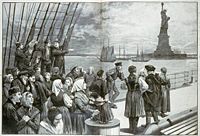| wiki | search |
During 1840 to 1860s, New York City underwent a permanent change socially and politically during the massive influx of immigrants – mainly from Great Britain, Ireland, and Germany. The vast influx mounted the racial tension between native-born workers and newly arrived immigrants; it held especially true to the blacks and Irish immigrants. By 1841, about 100,000 Irish Catholic immigrants have flooded into the city, and this number soared in the wake of the Irish potato famine in 1846. The blacks and Irish immigrants shared many commonalities in terms of social status and economic standing, yet they were forced to compete for the worst housings and lowest paying jobs in the city. According to the statistics provided by Joseph P. Ferrie, comparing to the newly arrived British and German, Irish had the worst downward trend in occupational change – 37.5% from white collar to unskilled and 52.2% from skilled to unskilled. Evidently, they faced direct competition for jobs in labor market with the blacks. Resentment and hatred resulted from competition escalated racial tension between these two groups. And as a result, ethnic violence and gang activities increased which inflamed civil disobedience in New York City.


